
The news that director Shinya Tsukamoto was concluding his “antiwar trilogy” with a film about the Tokyo firebombing was compelling. The March 1945 aerial attack killed more than 100,000 people in one night and yet receives much less attention than the Hiroshima and Nagasaki atomic bombings. Though such comparisons are inherently repulsive, the fact remains that most Japanese are not aware of the firebombing, which was carried out to kill as many civilians as possible. And, as pointed out in the recent documentary, Paper City, the government of Japan seems to prefer that people not remember the tragedy or even talk about it. As it turns out, Hokage isn’t really about the firebombing, but rather takes place shortly after the war has ended, centering on at least two characters who lost family in the March conflagration. Though the war and the awful destruction it visited on the Japanese populace is the backdrop, the action takes place in a contrived here-and-now that is all surfaces, and none of the main characters are given names. We see the aftermath without feeling the reality, and viewers who are not familiar with what Tokyo, or even the Japan home front, went through in 1945 may have questions.
The setting for the first half is a pub whose widowed proprietor (Shuri) has turned to prostitution in order to survive, since the only vocations available are provided by a local black market. An orphaned boy (Tsukao Oga) who has become adept at stealing food is taken in by the woman, and soon a traumatized young soldier (Hiroki Kono) also enters her life, ostensibly as a patron, but he stays, and the three, for a brief time, form a family unit, albeit one whose entire purpose is to find provisions and keep one another from going mad, an endeavor that isn’t entirely successful. Tsukamoto intensifies the unstable mood by limiting almost all the scenes to the interior of the pub, with its damaged walls and air of death, rendering the war an abstraction. The only time the story gets beyond these walls is in the protagonists’ nightmares, especially those of the soldier, whose violent mood swings threaten to tear the household apart, a possibility the boy is prepared for, much to the shock of the widow, who demands the soldier leave and the boy find real work.
The second portion of the film concerns this work, as the boy accompanies a man (Mirai Moriyama) out of the city on a mission of revenge. It is during this passage, instead of in the story about the traumatized soldier, that Tsukamoto overtly condemns the militarism that caused and drove the war, but since the earlier passage only referred to the war obliquely, through dream sequences and careful production design, the climax has less of an impact than Tsukamoto probably intended. At a recent press conference for the film, the director addressed this matter by saying he hoped the audience would “internalize” the story and imagine the war that he doesn’t show or, for that matter, even talk about. In that sense, Hokage adheres to the aesthetic he devised for the previous two parts of the trilogy, Fires on the Plain (1959), a more graphic remake of Kon Ichikawa’s 1959 film adaptation of Shohei Ooka’s book about his experience as a starving infantryman in the Philippines; and Killing (2018), about a samurai who despairs that the world he lives in won’t let him quit violence. Both movies focus on persons rather than events, and while they make powerful statements about trauma, they say little about war except that it’s terrible.
In Japanese. Opens Oct. 25 in Tokyo at Eurospace Shibuya (03-3461-0211).
Hokage home page in Japanese
photo (c) 2023 Shinya Tsukamoto/Kaijyu Theater
